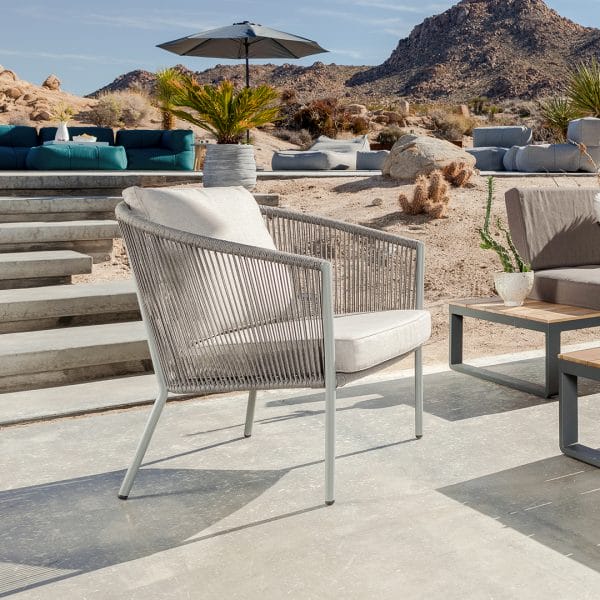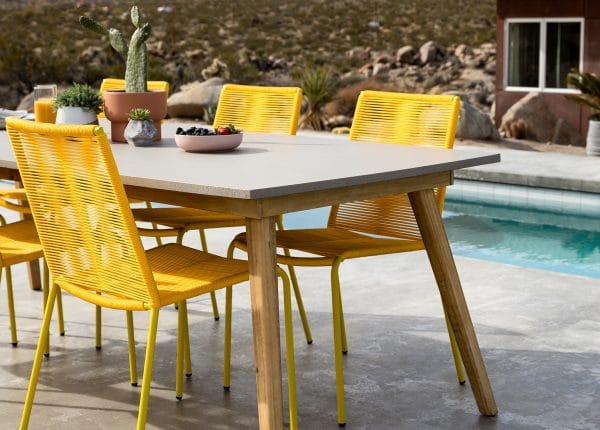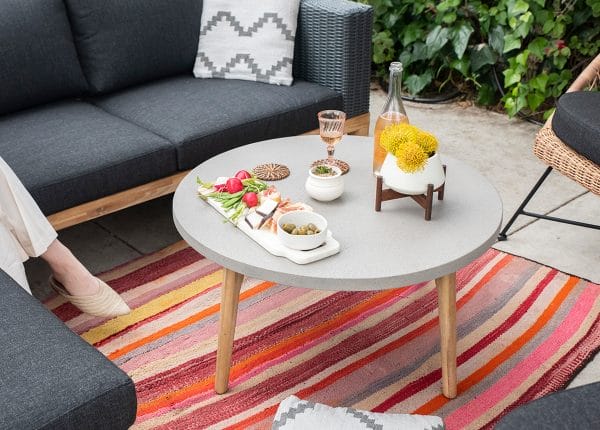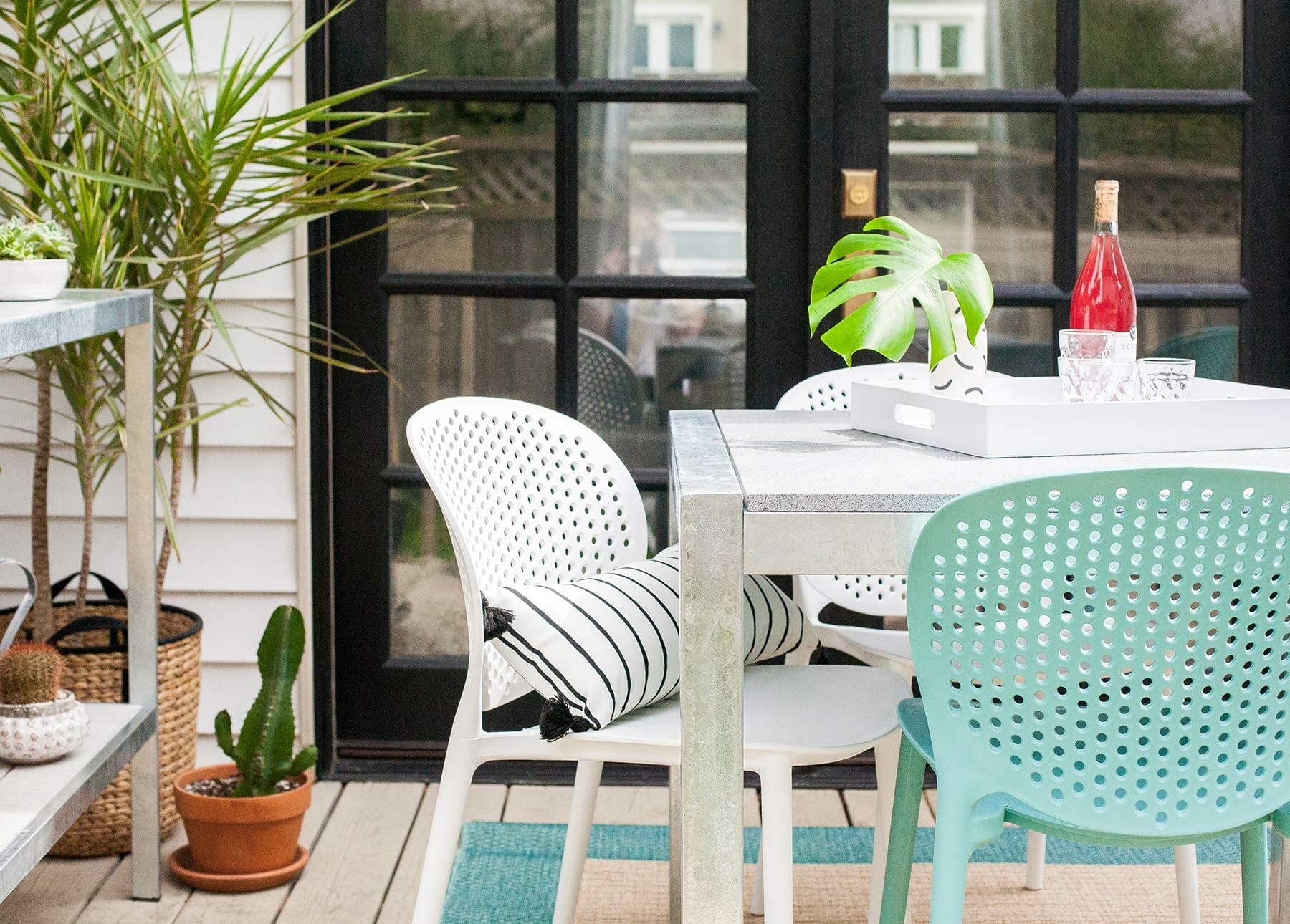The Best Modern Outdoor Furniture for Rain
Who doesn’t love a good, soul cleansing downpour? The unprepared owners of modern patio furniture, that’s who. Mildew, rust, corrosion, decay — rain can wreak havoc on ill-equipped outdoor pieces. Here some good news: rain doesn’t have to be the downfall of your beloved outdoor living room. With the right fabrics, materials, and a few protective measures, your patio furniture can weather everything from a little drizzle to torrential rains. Let’s dive in.
The Best Seating for Rain
The best seat for rain is a seat with no rain on it. No seat is actually made to sit out in a storm so it’s best to cover up or stash away your patio seating when you can. But of course, freak storms (and forgetful facepalm moments) happen. With those times in mind, some materials batten down the hatches much better than others.
Cushions You Can Count On
Cute: You, mimosa in hand, sitting on a patio sofa, sporting your favorite white jeans.
Not so cute: Also you, standing up from said sofa, sporting a soaked rear-end.
Blissfully unaware sitters beware: The waterlogged cushion is a boobytrap that has resulted in a fair share of soggy bottoms. Spongy pillows also create a breeding ground for mildew and mold, which is no good for your health — let alone the life of the cushion.

Made from moulded polypropylene, the Dot chair is in no danger of getting stinky, moldy, or squishy from a little rain. We love how John Lo of the Happy Mundane styled his Dot!
This is why the best modern patio furniture uses quick dry foam. Made for the outdoors, this miracle cushioning allows water to flow through it. High performance and high comfort, advances in cushioning technology (OoooOooo, awhhhhhh) have resulted in pillows that return to their naturally dry, marshmallow-y state in record time. While it’s always a good idea to lay wet cushions out in the sun after a good soak — surprise, surprise — quick dry cushions dry much faster than less resilient alternatives.
Infallible (But Fashionable) Fabrics
Sure you want a sofa that’s fade, stain, mold, water, life resistant, etc. but you also want to hang out without nippy fabrics pricking at your skin. Unlike the scratchy, stiff outdoor textiles of yesteryear, today’s best rain-ready fabrics are made to be comfortable and water repellant.
Polyester Fabric. For a tight knit and a tight look, polyester fabric holds its own in the rain with minimal shrinking or stretching. It’s because of its water repellent polyester exterior that the plush Caba sofa can withstand a light shower and quickly revert to its beautiful, ready-to-be-sprawled-on state. We try to avoid chemical sealants whenever possible so that our outdoor fabrics stay soft and shapely.

The Corda lounger is strung with polypropylene ropes and features a soft polyester fabric cushion. Perfect for all your outdoor exploits — even the slightly damp ones.
Acrylic Fabric. Acrylic is both a workhorse and a show pony, as evidenced by our Palo collection. Silky to the touch, easy on the eyes, but resistant to the rain, the Palo sectional is upholstered in 100% acrylic. One of the most durable fabrics, acrylic undergoes a unique engineering process where the acrylic is dyed before its fabric is knit together. The result? Colors — no matter how vibrant — won’t fade in the rain.
The Best Materials for Rain
Unless you have a combination of excess space and guns of steel (jealous), it’s unlikely you’re going to deadlift your mid-century outdoor dining table into storage every time raindrops are in the forecast. Outdoor dining tables, sofas, and chair frames need a solid foundation built by hardy materials. Here are our recommendations for best-in-showers.
Teak Furniture
Teak is a water warrior. Hailing from Asian forests prone to tropical downpours, teak trees are born to weather monsoon storms and humid settings; conditions that would cause other woods to rot.
Teak is inherently water resistant, which is why it’s the hardwood of choice for all kinds of wet environs, like boat decks and yacht floors. If teak can survive turbulent waters, it can certainly thrive on your patio. Teak’s seafaring prowess comes from its high oil content, which creates a shield against wet weather. What’s more is that teak has a tight grain that seals water out, providing an even higher degree of resilience and beauty.

The DIYPlaybook’s Casey Finn built a beautiful outdoor living space using the solid teak, water resilient Arca sofa to tie her patio together. We also spy a Bene lounge chair!
Polypropylene Furniture
Polypropylene is virtually impenetrable. Extraordinarily strong and durable, it’s immune to the effects of water. Moisture simply can’t permeate its dense material, and because it’s slick, mildew and rot can’t get a grip. Polypropylene is so sturdy it can even stand up to saltwater.

The Zina chair is strung with polypropylene rope for those extreme, all-weather party people.
Resin Wicker Furniture
Organic rattan is charming and earthy, but also a tad vulnerable. When exposed to excessive moisture or deluges of rain, raw rattan can lose its strength. To get the look of rattan with added weatherproofing, resin wicker is a great alternative. Aesthetically, it mimics the rattan palm’s natural texture so it keeps up the natural look you’re going for. Functionally, resin wicker combats Mother Nature’s wiley ways by its composition: rattan wicker is made of braided synthetic materials. The weave between the twine is so spacious, there’s no place for water to settle or moldy breeding grounds to fester.

The Loved Design Life enjoys dinners alfresco at the Teaka table, while kicking back in the rope Sala chair. When the weather turns, the only thing she needs to rescue is the wine.
Polystone Furniture
Polystone passes any test of nature or time. Since it doesn’t absorb water, it’s a great choice for rainy climates. If polystone conjures an image of using a sidewalk as a tabletop, let us clarify: polystone is really quite statuesque. Because it’s a cemented mix of powdered stone and polyurethane resin, polystone can be moulded and sanded into any shape. Its grainy texture imbues any patio with a touch of gritty-chic.

Natural elegance + industrial chic = truly timeless. In the beating sun or stormy weather, the polystone Atra table collection is equal parts beautiful and durable.
Aluminum Furniture
Metals are strong, unyielding, and seemingly invincible, but every superhero has its kryptonite. The unlikely champion of rain-enduring metals is humble aluminum. Why? Allow us to don our lab coats for a moment: rust is iron oxide and, unlike steel or iron, aluminum can’t rust because it has no iron in its composition. Instead, when aluminum oxidizes, it’s like a turtle retreating into its shell; a protective layer forms that seal the underlying unoxidized aluminum inside. This casing allows it to fend off moisture-induced corrosion far better than other metals. All this to say, aluminum is scientifically proven to be an excellent choice for rain. Chemistry lesson over.

Light weight, modern and completely aluminum, the Kopos table has a minimalist aesthetic with maximum rain resilience.
Furniture Self Love
While giving your furniture some TLC is less glorious than a monthly deep tissue massage, but a little upkeep ensures your furniture will live a long, beautiful life outside.
Sop up puddles and spills. Although outdoor fabrics are water resistant, they’re not entirely waterproof. Even though outdoor fabrics don’t foster mildew growth, mildew can still grow from soils or spills that aren’t cleaned up. Take care to shake out your fabrics and wipe away excess water after a rain.
Keep an eye out. Mildew is an opportunistic little surface fungus that’s always hunting for a damp cushion to grow on. If you spy powdery plumes of white, grey or yellow on your fabrics, don your rubber gloves, dish detergent, and a soft bristle brush or else that mildew might turn into mold — mildew’s bigger, badder, harder-to-remove evolution. For the whole enchilada on mildew extermination, read our blog post on how to protect your outdoor furniture.
Cover it up. We can’t talk about outdoor furniture for rain without touching on furniture covers. Kind of like Goretex but for furniture, covers aren’t the pinnacle of haute couture, but they are the best alternative to a ceiling.
Put it away. Weather forecasts tend to have the accuracy of a tabloid. Even if you check them diligently, it’s always a good idea to bring your fabrics inside — or better yet, store them (stylishly) — when you’re not using them. We love the Ora collection because it includes a cute little coffee table that doubles as refuge for delicate fabrics and cushions.
Whether you hail from a rainy climate or just habitually forget your cushions outside (hi!), the best offence is a good defence. By investing in furniture made from resilient materials and fabrics, your patio set up can survive everything from spring showers to morning dew for summers on end. And to that we say, make it rain.

